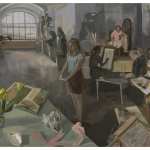The most radical thing about Frieze was not that it was curated, nor that it was on Randall’s Island, but that it stayed open on Monday, allowing one extra day to see what was on view. For years fairs have taken place over a long weekend, leaving little time for anyone to really digest or consider what is on view. Art journalists and critics, pressed for time, generally cover the fairs as commercial spectacles rather than thoughtful exhibitions, while grudgingly acknowledging the important role they have come to play in artists’ careers and galleries’ reputations. In effect, by not focusing on the quality of art at the fairs, mega-events that have come to define the contemporary art world, writers have handed the critical role over to collectors. Sales alone, which happen at breakneck speed during the fairs, now determine success. After the tents are packed up, the art goes into private collections with price alone determining the value.
Here are excerpts from recent coverage of the Frieze Fair, which focused not on the art but on all the other aspects of the fair.
At Art Forum Linda Yablonsky focused on paparazzi pictures of art celebrities and sales gossip. “�I sold that piece to New York, that one to an English collector, that to Brazil, and another to Australia,’ said a perspiring Alex Logsdail, indicating the cadmium yellow Anish Kapoor, a Ryan Gander, and two sound-and-light works by Haroon Mirza on the Lisson Gallery stand. Likewise, Sadie Coles couldn�t seem to write up sales fast enough. Gisela Capitain had no trouble unloading a Kippenberger painting. Many other works were small to medium-sized, with a concentration of cash-and-carry painting and sculpture and several examples of the sort of showmanship that is endemic to fairs.”
In the Wall Street Journal Katherine Clarke suggests Frieze will take over the fair world: “Despite Frieze’s slightly out-of-the-way location on Randall’s Island, off the east side of Manhattan, many dealers speculate that it is poised to become the preeminent event�not just in New York City, where the calendar has become littered with art fairs�but for the entire contemporary art market in America.”
At Art Info, Shane Ferro and Julia Halperin zone in on sales: “With Armory Show director Noah Horowitz and Armory Show co-founder Paul Morris spotted trolling the halls, there was much chatter about what this event might mean for the New York fair landscape. ‘It�s a much better range of galleries, and lots of them didn�t come to the Armory this year,’ said dealer Sean Kelly. ‘But we did seven-figure sales at the Armory and we�re doing well here. So far, there is room for both fairs.'”
At Art Fag City, Paddy Johnson covered the political angle. “Frieze talks aren�t free�they come at a 40 dollar ticket price�and on Thursday police shut down the Occupy protests over Frieze�s labor decisions. Tomorrow there will be a talk about Occupy at Frieze without a single Occupy representative. It seems Frieze won�t be welcoming much discussion after all.”
By displaying the work of hundreds of artists (thousands if you consider that numerous art fairs run concurrently) for such a short period of time, galleries guarantee a kind of Teflon coating for the pieces they present. None will get serious consideration unless it is so large and remarkable (or tasteless) that everyone comments on it (i.e., the nutcracker, the sausages). Responding to Holland Cotter’s review, one of the few articles that discussed individual pieces of art, journalist-blogger Tyler Green was dismissive, suggesting that reviewing an art fair is like reviewing Barnes & Noble. However demanding, due critical consideration for individual artists and projects presented are exactly what we need.
In a recent New Yorker piece, Peter Schjeldahl concluded that the fairs have opened a “spiritual gulf between those who buy art and those who only love it.” Summing up the history of art fairs, the earliest of which took place in Cologne in the 1960s, Schjeldahl suggests that fairs have changed not only how art is bought (really, really fast), but how art is made. He’s right.
It seems to me that galleries participating in four or five fairs each year, plus gallery exhibitions, put an inordinate burden on artists to produce enough work to keep up. Has the ability to produce a large quantity of work become more important than the quality of the work itself? Perhaps taking art fair art more seriously, logistically difficult though it would be, might be one way critics could play a significant role in the process. After all, it looks as though the fairs, which have expanded the collector base by making art collecting fun, are here to stay.
——-
Subscribe to Two Coats of Paint by email.

















Good points Sharon. I've also noticed that many art journalists often criticize the glitz and glamour of fairs, while simultaneously boasting about what parties they had access to. It would be refreshing to talk about the work. Looking forward to your artfair artwork reviews.
Excellent article! Thank you for writing about this subject. Would love to see more coverage/reviews of the larger art fairs.
Thanks Cable. I'm not sure this little epiphany will effect my coverage of the recent fairs, but I'll cover fairs differently in the future.